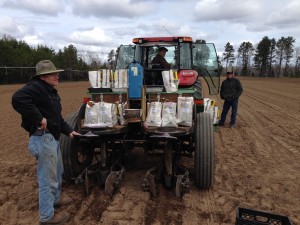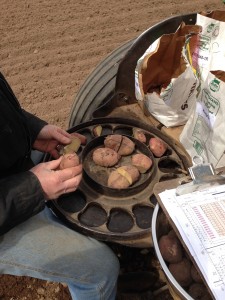The ground is finally ready for planting at the Rhinelander Research Station. Last week we planted the seed maintenance plots for our most advanced breeding lines. Each plot contains 80 plants (or hills), which is enough to repopulate an 80-hill plot next year and provide seed for production trials at several locations, such as the Hancock Research Station. The seed drill pictured below is a specialized machine that allows us to plant in “tuber-units,” using seed tubers that have been partially cut (e.g., two cross-cuts to make four seed pieces). The tuber is broken into pieces at planting time and placed sequentially in the slots of a rotating wheel, with a skip between tubers. The horizontal wheel moves the seed pieces over a chute that drops them into the furrow.
The tuber-unit planting method is used to facilitate the removal of virus-infected plants during the growing season. If the foliage of one plant is observed to have mosaic virus symptoms, most likely all of the plants from the same seed tuber are infected, and the whole group of plants is removed from the plot.


